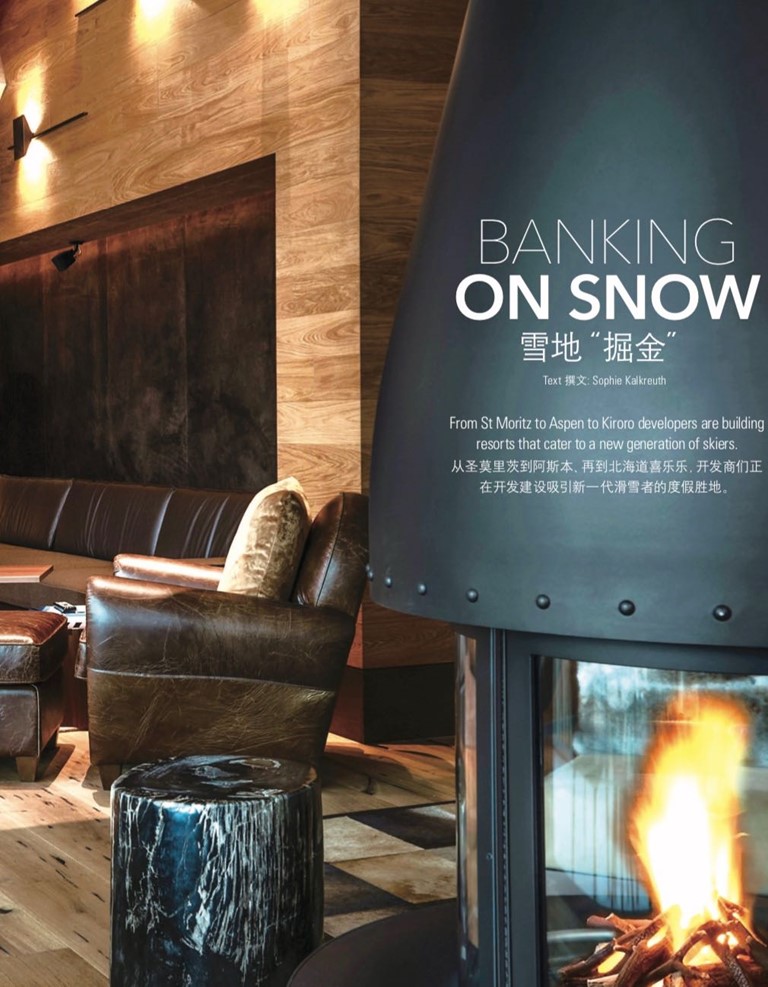LP Luxury Properties Magazine (China) - July 2019, BANKING ON SNOW

BANKING ON SNOW
From St Moritz to Aspen to Kiroro developers are building resorts that cater to a new generation of skiers.
ACCORDING TO KNIGHT FRANK, SKI PROPERTY VALUES ACROSS THE FRENCH AND SWISS ALPS DECLINED BY 0.5% IN THE YEAR TO JUNE 2018.
After a few patchy years, this winter has seen spectacular snowfall in resorts around the world. In the US, Aspen had mounds of fresh powder by Christmas. In Switzerland, anyone willing to brave the wind and low temperatures had spectacular skiing over New Year’s. And in Hokkaido, Japan, nearly 400 cm of the famous white powder accumulated in December alone.
But in Alps, even as people lined up for ski rentals and jockeyed for tables at Europe’s highest summit lodges, the real estate around them had settled into a buyer’s market. According to Knight Frank’s annual Ski Property Index, ski property values across the French and Swiss Alps declined by 0.5% in the year to June 2018.
The best performing resorts were the Swiss villages of Villars (6 percent) and Verbier (3.4 percent), which have both lagged behind in recent years. But a surge in investment, both in terms of ski lifts, luxury hotels, beginner areas and non-ski activities have boosted tourist numbers, buyer demand and hence chalet pricing.
“There has been a growing recognition of the relative value available in Villars,” the report notes. “Home to three international schools, the resort also attracts a number of parent buyers seeking a nearby base.” Meanwhile Verbier’s ease of access, its southern-orientation – making it one of the Alps’ sunniest resorts – and its broad range of leisure activities also explain its high ranking.
But elsewhere in Switzerland the strength of the Franc has deterred buyers. St Moritz, largely regarded as the birthplace of winter tourism, (it has been an alpine resort since 1864), is one of the country’s most exclusive resorts and one of few accessible by private jet. However, the robust Franc along with high pricing and a mismatch between demand and supply have seen prices soften.
There is pent up demand for smaller units but the bulk of current inventory is comprised of older, larger style chalets that are off limits to international buyers. “Foreigners are not allowed to buy property without taking residence in Switzerland, and this has significant tax implications,” explains Herbert Wust or Wust & Wust Associates, an affiliate of Christie’s International Real Estate. “It limits the market significantly.”
There will always be demand for chalets among the world’s wealthiest, Wurst says, after all Switzerland is considered an extremely secure place to invest and boasts an enviable quality of life and some of the world’s best schools, but he describes the status in St Moritz is “quiet”.
Some Swiss developers have found ways around the country’s red tape. A 2013 ruling known as Lex Koller set a 20% cap on the number of second homes in each Swiss commune, but by creating hotel-style residences with services such as a concierge, buyers are still able to purchase a holiday home provided they rent the property when not in use. In most cases, the owner can use their ‘residence hoteliere’ up to a maximum of six weeks per annum.
The serviced apartments at The Grace Hotel in St Moritz, for example, can be bought freehold by buyers with or without Swiss residency. The property, which is currently undergoing extensive refurbishment, is set to include an onsite spa fitness center, restaurants, martini and cigar bars and 24-hour concierge. Prices start from US $664,500 and US $4.4 million for a two-bedroom apartment.
Foreign buyers are also exempt from Lex Koller at the Chedi Resort and Residences in Andermatt, which includes 2,400 square meters of spa and fitness facilities with a 35-metre indoor pool. A 100 square meter one-bedroom suite with a private terrace is currently listed for US $2,497,000 with Wetag Consulting.
Regulations aside, hotel-style residences also appeal to a new generation of skiers, says Jeremy Rollason, director of Alpine homes with Savills in London. Younger buyers want a whole range of amenity and entertainment options at their fingertips, he says, and resorts can remain competitive by organizing cultural events and reinvesting property taxes into resort facilities such as health spas, children’s play areas and other amenities.
“Y generation wants a 24-hour ski/party experience”, he says. “X generationers were quite happy with a fondue and glass or two of Gluhwein, but millennials want sophisticated wine bars, live music or celebrity DJ’s, internet everywhere and world class restaurants that offer all day Brassiere style food at sensible prices”.
Lifestyle trends are important in a second-home or holiday market since demand is driven largely by cash buyers with disposable income rather than speculators looking for investments, Rollason adds.
Across the Atlantic developers are also updating their resort developments. Denver-based East West Partners is currently building Snowmass Base Village, a mountain-resort community located about 15 minutes from Aspen, Colorado, that aims to offer a 24/7 ski resort experience.
“We really saw that today’s second home owners were looking for something more contemporary,” says Sue Hyde, Director of Marketing at East West Partners. Although America’s ski home market has rebounded from the financial crisis, Hyde says not much has been built over the last decade.
LIFESTYLE TRENDS ARE IMPORTANT IN A SECOND-HOME OR HOLIDAY MARKET
The new residences at One Snowmass, which range from US $1.985 million up to grand penthouse US $7.895 million, were designed by Denver-based 4240 Architecture and blend a ski-lodge aesthetic with mid-century touches and corner glass to capture the views. The project integrates a range of amenities: a large fitness center, a ski- in / ski-out locker room (there are gondolas within walking distance), a private lounge, and a roof terrace with a fire pit and views over the village plaza and Mt Daly. And the developers also partnered with luxury hospitality brand Inspirato, giving buyers access to luxury residences around the world and the option of Inspirato’s rental management program.
While established ski areas upgrade their infrastructure, newer resorts in Hokkadio are maturing into lively places to ski and stay. Resorts like Hirafu, Hanazono, Niseko Village and Annupuri, known for some of the country’s best skiing, have in recent years elevated their culinary and residential offerings too. “First and foremost, it is the snow that draws people to Hokkaido,” says Craig Meikle, director of Niseko Realty. “A close second is the food.”
Chinese skiers, who are becoming increasingly active in European ski property market, already comprise a large percentage of property purchases in Hokkaido. Drawn by freehold ownership, a weaker Japanese yen, and high capital gains, agents say the majority of international buyers in Hokkaido hail from Hong Kong (China), followed by Singapore, Thailand, Malaysia and South Korea.
Overall property values in Niseko have risen steadily since 2012. A 2018 Niseko Property Market Update from C9 Hotelworks notes that the average price for a condo in the Niseko resort rose 25 percent compared to the previous year. “Apartments are pushing between US $12,500 and US $14,300 per square meter,” Mr. Meikle says, “with penthouses in some projects fetching as much as US $26,800 per square meter.”
As land values rise, developers are also building in lesser-known resort areas. Property Perfect Public Company recently announced plans to transform Kiroro mountain village, located northeast of Niseko, into a year-round alpine destination. The Thailand-listed company, which acquired Kiroro Resort in 2012, is investing US $900 million over the next decade to create a destination encompassing hotels and residences, a restaurant and bar scene, shops and other mountain amenities.
“Kiroro has a great foundation,” says Saranyu Adhyanasakul, the company’s Director of International Business Development. The key to success, he estimates, is being able to expand the premium development without starting from the scratch. “The number of lifts are similar size to Hirafu at Niseko, while the number of land bank is much more. The competitive advantage is our ability to expand the ski-in ski- out to any developments within this exclusive valley.”
Yu Kiroro, a residential component scheduled for completion in late 2019, offers 108 freehold ski-in ski-out residences ranging from apartments with one, two and three bedrooms to larger penthouses. The apartment interiors are designed to maximize views of the slopes and surrounding forests and come fully furnished in Japanese alpine style. Amenities include ski vale, indoor-outdoor onsen, 24-hour concierge, fitness center and lounge, and all-day dining options.
Hokkaido isn’t the only area that stands to gain from changes in the global ski market that is moving activity steadily east. By the year 2020 the world’s ski resorts are forecast to attract more than 420 million ski visits per annum with the largest growth happening in parts of Asia and Eastern Europe, including China, South Korea, Bulgaria and Kazakhstan.
And if the last few winters are any indication, established ski resorts in Europe and America will have to contend with other climatic changes too. Winter has become increasingly unpredictable in recent decades, and though warmer oceans are fueling stronger winter storms, warmer air temperatures mean that snow doesn’t stick around as long. If climate predictions are correct, two-thirds of European ski resorts will be likely to close by 2100. In other areas, like the northeast US, more than half of the 103 ski resorts may no longer be viable in as soon as 30 years.
For the moment, agents like Herbert Wust in Switzerland recommend sticking to resorts like at higher elevations like Zermatt and St Moritz. “As a general rule, once you are at 2,000 meter altitude you’re better off than somewhere like Gstaad, which is located at 1,2000 meters,” he says.
Hokkaido’s ski resorts haven’t experienced the effects of warmer weather in the same way Japan’s main island has, says Adhyanasakul. “Kiroro is among the snowiest resorts in Asia and still receives over 20 meters of powder snow each winter”. Exactly how and how quickly climate change will affect ski resort areas remains to be seen, but for now, developers remain bullish about a bright white future.
WETAG CONSULTING IMMOBILIARE SA
Luxury Real Estate for sale in Ticino, Switzerland
Riva Antonio Caccia 3
CH-6900 Lugano
Via Antonio Ciseri 13A
CH-6600 Locarno
Via Monte Verità 1
CH-6612 Ascona
www.wetag.ch
www.journal.wetag.ch
[email protected]
+41(0)91 601 04 40


